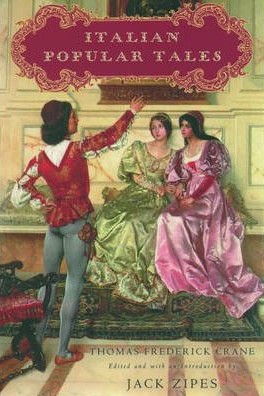
I think it’s time to step away from the Grimms’ stories for a little while. I’ve mentioned before that I find it interesting to see how similar stories are told in different cultures, each with their own variations. I was thinking this month it would be fun to look at some of the Beauty and the Beast variations. It always seems a rather romantic story which works well with Valentine’s Day, too.
Today’s tale, “Zelinda and the Monster,” comes from Italy and was retold in Italian Popular Tales by Thomas Frederick Crane, published 1885.
Zelinda is the youngest daughter of a poor man. I like when fairy tale characters have actual names, rather than being referred to as the princess or the youngest. Zelinda is of course lovely and kind and her two older sisters were jealous of her, but of course she is her father’s favorite. The father has to go to the market in a neighboring town and offers to bring back gifts for his daughters. He easily purchases a dress for one and a shawl for the other, but can’t find the rose Zelinda requested.
On the way home, the father passes a garden with a partially open gate. He quietly enters and sees a gorgeous rosebush, but there is no one around whom he can pay for on of the roses, so he picks a rose, just like the father in de Beaumont’s “Beauty and the Beast.” Immediately, a monster appears and states the man must die. The father begs and pleads and finally the monster agrees to allow him to leave as long as he brings back the girl who asked for the rose, and she will die instead.
The man returns home and tells his daughters all that happened. Zelinda, good girl that she is, of course offers to go the garden. Father and daughter returned to the garden and found the palace lit up. They enter and statues show them to a lavish dinner and then up to two bedrooms where they spend the night. The next morning, they find the monster who sends the father away.
When the monster and Zelinda are alone, the monster becomes quite kind. He “began to caress her, and make loving speeches to her.” A little creepy if you ask me, but apparently not to her. He asks her daily if she will marry him and she always replies, “I like you, sir, but I will never be your wife.” The monster tells her that he has a marvelous secret, but can’t tell her until after they are married. I’m sure if she had known she was in a fairy tale, she could have guessed the secret, but she didn’t know so she wasn’t swayed. After all, he was still ugly and she did not want to marry a monster.
Finally one day he’s calls her and tells her that her father is on his deathbed and that will die if she doesn’t agree to be his wife. She promises to marry him, desperate to save her father. “Scarcely had Zelinda uttered these words when suddenly the monster was transformed into a very handsome youth. Zelinda was astounded by this unexpected change, and the young man took her by the hand, and said, ‘Know, dear Zelinda, that I am the son of the King of the Oranges. An old witch, touching me, changed me into the terrible monster I was, and condemned me to be hidden in this rosebush until a beautiful girl consented to become my wife.'”
And that’s where the story ends. I’m going to have to assume that the father lives, and Zelinda and the prince marry and live happily ever after, even though I feel like she was tricked. She didn’t eventually fall in love with him because he was so good and loving, she was more or less forced into it. I was a little curious about the “King of the Oranges,” so I did a very quick bit of research. Apparently there is an area in southern France that was the Principality of Orange. I don’t know if that is what the story is referring to, but it makes more sense to me than being the king of a fruit.
Ivrea, Italy also has a Battle of the Oranges that coincidentally takes place in February. The festival commemorates the city’s defiance against a 12th or 13th century tyrant. This tyrant attempted to rape a young miller’s daughter on the eve of her wedding. His plan backfired when the young woman instead decapitated him, after which the townspeople stormed and burned the palace. Every year the citizens remember their liberation with the Battle of the Oranges where teams of “Aranceri” (orange handlers) on foot throw oranges (representing ancient weapons and stones) against Aranceri riding in carts (representing tyrant’s ranks). During the 19th-century French occupation of Italy the Carnival of Ivrea was modified to add representatives of the French army. So basically, you’ve got thousands of people throwing oranges at each other in Italy’s largest food fight.
Thursday’s Tales is a weekly event here at Carol’s Notebook. Fairy tales, folktales, tall tales, even re-tellings, I love them all.

I can only say you go girl for the chopping of his head in the real story
And cool, Zelinda
That is really interesting! I prefer the idea that ‘beauty’ loves and choses him in spite of his uglyness rather than the idea she does it just to save her Father as well..but I love reading variations of this story!
I like the other version of ‘Beauty and the Beast’ better. The fact that the Beast practically blackmailed Zelinda to marry him is outrageous. It wasn’t a real love by the way so the charm worked strange.
According to the story, the curse had nothing to do with real love, she just had to agree to marry him. Still seems cheap to me.